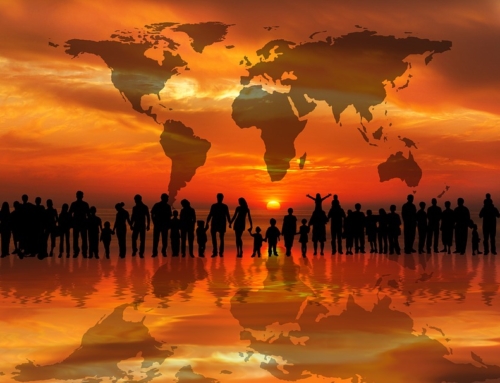AR6 – CLIMATE CHANGE AND THE NEED TO REDUCE METHANE EMISSIONS INTO THE ATMOSPHERE
The IPCC Working Group 1 report was published yesterday, 9 August 2021, and is the first instalment of the Sixth Assessment Report ‘AR6’ which will be completed in 2022.
743 scientists from around the world analyzed about 174,000 specific studies, observing climate change that is unprecedented in thousands of years, if not hundreds of thousands of years.
““This report reflects extraordinary efforts in exceptional circumstances.. ““The innovations contained in this report and the advances in climate science reflect it as an invaluable contribution to negotiations and decision making.””.
Hoesung Lee, Chair of IPCC (Intergovernmental Panel on Climate Change).
The report shows that emissions of greenhouse gases from human activities are responsible for approximately 1.1 °C of warming since 1850-1900, and finds that averaged over the next 20 years, global temperature is expected to reach or exceed 1.5 °C of warming.
This assessment is based on improved observational datasets to assess historical warming, as well as progress in scientific understanding of the response of the climate system to human-caused greenhouse gas emissions.
““This report is a reality check” . We now have a much clearer picture of the past, present and future climate, which is essential for understanding where we are headed, what can be done, and how we can prepare”.
Valérie Masson-Delmotte, Working Group 1 Co-Chair 1
The report states that unless there are immediate, rapid and large-scale reductions in greenhouse gas emissions, limiting warming to close to 1.5 °C (or even 2 °C) will be beyond reach.
Every region of the Earth faces climate changes which are increasing and which directly depend on the level of global warming.
“Climate change is already affecting every region on Earth, in multiple ways. The changes we experience will increase with additional warming.”.
Panmao Zhai, IPCC Working Group I Co-Chair
Climate change is not just about temperature but also include changes to wetness and dryness, to winds, snow and ice, coastal areas and oceans. By way of example only, some specifics of the report are set out below:
- • Climate change is intensifying the water cycle. This brings more intense rainfall and associated flooding, as well as more intense drought in many regions.
- • Climate change is affecting rainfall patterns. In high latitudes, precipitation is likely to increase, while it is projected to decrease over large parts of the subtropics. Changes to monsoon precipitation are expected, which will vary by region.
- l• Coastal areas will see continued sea level rise throughout the 21st century, contributing to more frequent and severe coastal flooding in low-lying areas and coastal erosion. Extreme sea level events that previously occurred once in 100 years could happen every year by the end of this century.
- • Further warming will amplify permafrost thawing, and the loss of seasonal snow cover, melting of glaciers and ice sheets, and loss of summer Arctic sea ice .
- • The report states that changes to the ocean, including warming, more frequent marine heatwaves, ocean acidification, and reduced oxygen levels have been clearly linked to human influence. These changes affect both ocean ecosystems and the people that rely on them, and they will continue throughout at least the rest of this century.
- • For cities, some aspects of climate change may be amplified, including heat (since urban areas are usually warmer than their surroundings), flooding from heavy precipitation events and sea level rise in coastal cities.
For the first time the AR6 provides a more detailed regional assessment of climate change, including a focus on useful information that can inform risk assessment, adaptation, and other decision-making, and a new framework that helps translate physical changes in the climate into what they mean for society and ecosystems. This regional information can be explored in detail in the newly developed Interactive Atlas (https://interactive-atlas.ipcc.ch/) where regional fact sheets are also available
““It has been clear for decades that the Earth’s climate is changing, and the role of human influence on the climate system is undisputed”.
Masson-Delmotte
So, if human influence plays a role on past and future climate, how can we limit future climate change? The IPCC states that it is not enough to limit the human-caused contribution of carbon dioxide (CO2) into the atmosphere as other greenhouse gases emitted in free form also contribute to influencing the climate, with particular reference to methane (CH4).
“ Stabilizing the climate will require strong, rapid, and sustained reductions in greenhouse gas emissions, and reaching net zero CO2 emissions. Limiting other greenhouse gases and air pollutants, especially methane, could have benefits both for health and the climate. ”.
Panmao Zhai – climate scientist
But what is the methane in the atmosphere generated by?
“Methane in the atmosphere is generated by many different sources, such as the development and use of fossil fuels, the decay of organic matter in wetlands, and as a by-product of livestock farming. Determining which specific sources are responsible for the variations in the annual increase in methane is difficult. Preliminary analysis of the carbon isotope composition of methane in NOAA air samples carried out by the Arctic and Alpine Research Institute of the University of Colorado, indicates that a major factor in the increased methane load is likely to come from BIOLOGICAL SOURCES di metano csuch as wetlands or livestock rather than thermogenic sources such as the production and use of oil and gas” (fonte: Research NOAA).
In the current climatic context, can we perhaps allow ourselves to overlook the fact that biogas from waste (e.g. landfill gas – LFG) also contains the methane macro-component of biological origin? Typical or standard biogas (LFG50) is characterized by a % vol of methane CH4 equal to 50% and a % vol of carbon dioxide CO2 equal to 35% (source: EPC Libri – ‘Biogas da Discarica’ by Enrico Magnano).
.
Shall we take into consideration that, worldwide, over 60% of waste is disposed of in landfills (controlled landfill, sanitary landfill – with landfill collection, landfill unspecified, open dump…) and that municipal waste landfills are major producers of biogas, given that normally 30 to 50% of waste is composed of organic material? (source: What a Waste 2.0 – World Bank Group, 2018)(controlled landfill, sanitary landfill–with landfill collection, landfill unspecified, open dump, …).(fonte: What a waste 2.0 – World Bank Group, 2018)
Can we then overlook the fact that the phenomenon of biogasification of waste, once started, continues for at least 30 years, so the waste disposed of today will produce biogas until 2051?
““It has been clear for decades that the Earth’s climate is changing, and the role of human influence on the climate system is undisputed”.
Masson-Delmotte
“ Stabilizing the climate will require strong, rapid, and sustained reductions in greenhouse gas emissions, and reaching net zero CO2 emissions. Limiting other greenhouse gases and air pollutants, especially methane, could have benefits both for health and the climate. ”.
Panmao Zhai – climate scientist
Finally, let’s consider the most up-to-date data from the Italian national inventory of emissions (source: Environmental Data Yearbook 2019, 89/2020, ISPRA – Table 7.4 and Figure 7.4.b) which identify landfills as the second greatest source of methane emission into the atmosphere, with a contribution equal to almost one third of the total of sources identified, second only to agriculture and even more important than the energy sector.


